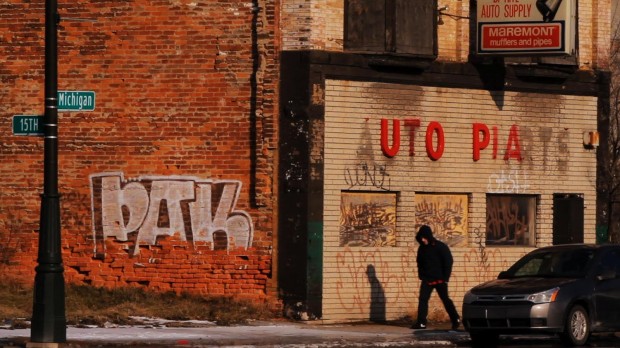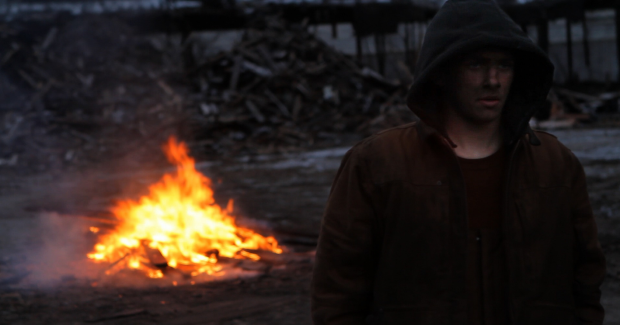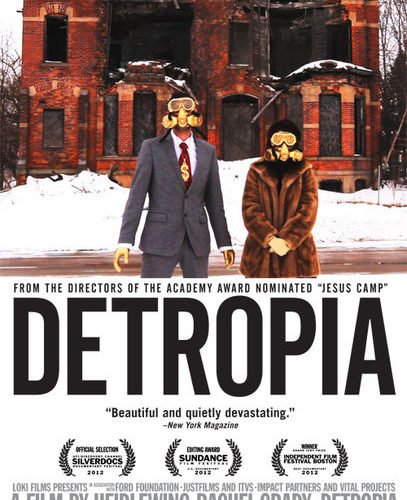One of the gifts of directors Heidi Ewing and Rachel Grady have shown through their documentary film career is their ability to fragment large social topics through a human narrative. In their breakthrough documentary Jesus Camp, the team examined the growth of Evangelical Christian movement in America through the extreme education of a few youths, lending us a bottom-up view on why this particular religion is taking such a hold. The country-wide debate of abortion was played out on one corner in Florida in 12th and Delaware, taking the debate out of the hands of politicians and following the action on one street corner, where an abortion clinic sits across the street from a pro-life/anti-abortion clinic. Ewing and Grady have a gift to make the big problems small, manageable, and emotional. We aren’t talking about abortions, we’re talking about a fetus inside this woman, who seeks help from these people.
They consciously eschew this style of film making in their latest film, Detropia, a documentary on the crumbling of Detroit, self-distributed through their company Loki Films. The directors landed in Detroit amidst its stark economic downfall in 2009 and documented an economic crisis that has no solution in sight. Not that they seek to find one, necessarily. Detropia oversees all with a detached eye, featuring numerous shots from high above the troubled grounds below like an absentee God, omniscient but unable to answer the cries of its citizens. In one section, George McGregor, president of a local union of auto workers, appeals to the filmmakers for some guidance, some idea of where to go. They refuse to answer. We get to sit shotgun as a culture, a city, a people crumble away, as paralyzed to stop it as Detroit’s denizens themselves.

The audience never latches onto one character, mostly because they aren’t allowed to. Detropia puts a number of people front and center, never letting us grab hold of one person and follow their struggle throughout. Among the revolving door of Detroit residents are the aforementioned McGregor who tries desperately to keep an American Axle factory from heading south to Mexico’s cheaper shores. There is a poignant moment at the head of the film where McGregor informs his workers of the latest wage offer from the company (cuts upwards of $3.00 per hour) and they vote out of pride to not accept the rates. While it’s doubtful American Axle ever thought they would accept the offer, at least the workers can hold on to some of their pride before entering the growing unemployment pool. We look on, wide-eyed and horrified.
Without a main character to latch on to, the through line of the film becomes the look of utter devastation. It starts early, with a crane pulverizing one house within the city’s untenable 139 square miles, one of the 90,000 houses that will cease to exist over the year. It’s a staggering statistic, but soon becomes just another in a long line of bottom-third crawls of just how bad things are, as showing could not possibly tell the whole story. How could it? A person doesn’t even have the time necessary to watch 90,000 homes be turned to rubble, nor is there an audience masochistic enough to watch them all fall.

Soon the film becomes a breeze through of some of the myriad problems the city is going through without ever making a sincere connection with anyone. We watch as a group of men in their mid-to-late 20s gather scrap metal and pack the unwieldy stash in the back of a 15 passenger van, as most of the copper hangs out the back. We don’t know who these people are, where they come from, what their previous jobs were, what they want to do with their lives. We just know that they’re scrapping, most likely because they have to, in a night scene light gorgeously by a burning fire in the middle of what used to be a bustling housing development, or a park, or a school. That is devastating on its own, but it can only go so deep.
The few connections we do make are fleeting. Take the video blogger Crystell Starr whom we follow around as she captures decaying churches, high schools, and other large, formerly robust buildings. But she acts largely as a cypher – she sees what we see. We are shown footage of her personal testimonial for her website which essentially says how terrible this all is, as if we couldn’t already make that point on our own. Later, during a particularly disastrous, packed town hall meeting set-up to discuss the possibility of shrinking the monstrous city through forced relocation, we find Crystell in the crowd. She offers up how uncoordinated it all is. The one knowing moment comes when two Europeans enter the cafe where she works and they kibitz over coffee, discussing in polite terms the issues occurring in Detroit after mildly offending her by commenting on the state her city). That sting is an emotional beat that is few and far between.

Towards the middle of the film we cozy up with Tommy Stephens, a former teacher who knows runs the Raymond Lounge, a once busy bar and restaurant that would serve the workers of a nearby auto factory. Business hasn’t been too good lately. He attends the Detroit Auto Show to see how the Chevrolet Volt is doing. It’s a personal investment for Stephens as its success could bring jobs back to the factory and bodies back in his bar. But once there, he notices a Chinese electric car, one that’s cheaper and gets better gas mileage. When he confronts the Chevy agent, he mentions how they don’t have the amenities the American car does and to not worry about it. Sound familiar? Stephens sighs. We sigh along with him.
As a document showing the devastation of Detroit, this film is fantastic. It’s haunting and perversely gorgeous, courtesy of Tony Hardmon and Craig Atkinson‘s bravura cinematography. But that superficial compliment is indicative of the film’s overall experience. I know that Detroit was going through tough times, and now I have a great idea of how dire that situation looks. But with the talent at hand, I wonder why the involved did not make a better effort to have us feel what it’s like to have your city crumble around you.
Detropia is now in limited release.

